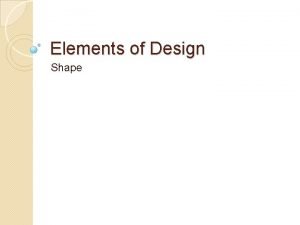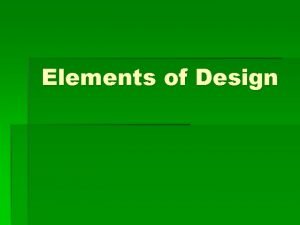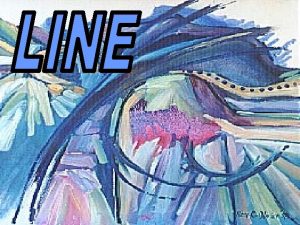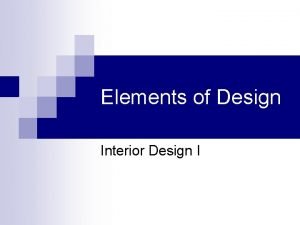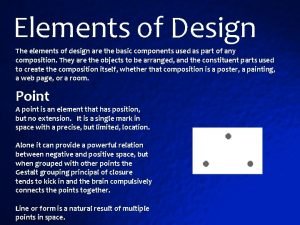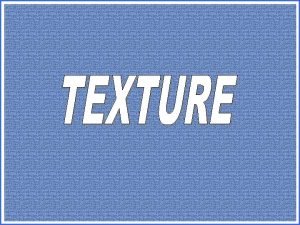The Elements of Design Elements of Design The










- Slides: 10

The Elements of Design

Elements of Design The basic components used by the artist when producing works of art. Those elements are: • Shape • Form • Value • Line • Color • Texture • Space

Shape An enclosed space defined and determined by other art elements such as line, color, value, and texture. Shapes can be categorized into two different types: Geometric and Organic An irregular shape, or one that might be found in nature, rather than a regular mechanical shape. Geometric Shapes that are created through use of mathematics. These shapes include Circle, Oval, Triangle, Square, Rectangle, Hexagon, Octagon and Pentagon.

Form An element of art that is three dimensional (height, width, and depth) and encloses volume. For example a triangle, which is two dimensional, is a shape, and a pyramid, which is three dimensional is a form. Examples of forms include: Cubes, Spheres, Ovoids, Pyramids, Cones and Cylinders.

Line A line is the path of a point. Often it defines a space and creates an outline or contour, defines a silhouette, create patterns, or movement, and the illusion of mass or volume. It may be two-dimensional (as with pencil and paper), three-dimensional (as with wire) or implied (the edge of a shape or form. ) Types of lines include; vertical, horizontal, diagonal, straight or ruled, curved, bent, points, angular, thin, thick, or wide, interrupted (dotted, dashed, broken) blurred or fuzzy, controlled, freehand, parallel, hatching, cross-hatching, meandering, and spiraling.

Value An element of art that refers to the lightness or darkness of a color. Value is an especially important element in works of art when color is absent. This is particularly likely with drawings, lithographs, photographs, and sculpture. Value Scale A gray scale, a series of spaces filled with the tints and shades of one color starting with white or the lightest tint on one end, and gradually changing into the darkest shade or black on the other.

Color Produced by light of various wavelengths, and when light strikes an object and reflects back to the eyes. Color can be mixed from red, yellow, and blue, can be combined to make new colors, can be mixed for intensity and value, can express moods and feelings, can be warm or cool, can give the illusion of distance.

Properties of Color Hue/Tone The name of a color. The primary hues are red, yellow, and blue. Intensity Refers to the brightness and dullness of a color.

Texture An element of art, texture is the surface quality or "feel" of an object, , its smoothness, roughness, softness, etc. Textures may be Actual or Implied. While implied textures are suggested by an artist in the painting of different areas of a picture — often in representing drapery, metals, rocks, hair, etc. Actual textures can be felt with the fingers.

Space An element of art that refers to the distance or area between, around, above, below, or withings. It can be described as two-dimensional or threedimensional; as flat, shallow, or deep; as positive or negative; and as actual, or illusory.











